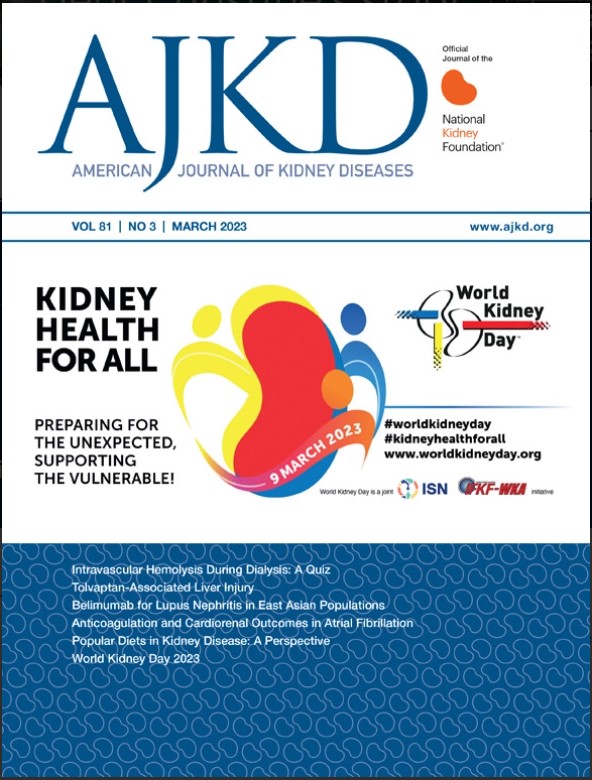常染色体显性多囊肾病骨骼肌质量和体重指数与临床预后的关系:一项观察性研究
IF 8.2
1区 医学
Q1 UROLOGY & NEPHROLOGY
引用次数: 0
摘要
理由与目的低肌肉质量是慢性肾脏疾病的危险因素。在这项研究中,我们研究了常染色体显性多囊肾病(ADPKD)患者的肌肉质量与死亡率以及终末期肾病(ESKD)之间的关系。研究设计回顾性队列研究。环境与参与者:2006年至2020年间,韩国8家三级医院的1443例ADPKD患者。在第三腰椎处获取计算机断层图像,使用人工智能系统测量骨骼肌面积(SMA)。SMA根据肌肉质量分为低衰减肌区(LAMA)和正常衰减肌区(NAMA)。结果:全因死亡率和ESKD。分析方法:采用cox比例风险回归,校正性别、年龄、肌酐、血糖和身高调整后的总肾体积,研究肌肉指标与全因死亡率和ESKD的关系。根据体重指数分类进行亚组分析:低或正常(<25 kg/m2)和超重或肥胖(≥25 kg/m2)。结果研究人群中女性患者占一半以上,肾小球滤过率平均估计为68.4 ml/min/1.73m2。平均随访5.14年。较高的SMA/height2和NAMA/height2与较低的死亡风险相关(hr分别为0.58 (95% CI 0.39-0.88)和0.55 (95% CI, 0.39-0.79))。较高的NAMA/height2与ESKD发生率降低26%相关(0.74(0.59,0.92),但较高的LAMA/height2与较低的ESKD发生率相关(HR 1.18, 95% CI 1.01-1.37)。较高的NAMA/LAMA比值与较低的ESKD发生率相关(HR 0.74, 95% CI 0.60-0.92)。在超重人群中,更大的肌肉质量与更低的死亡风险相关,在体重不足人群中,更低的ESKD风险相关。限制:缺乏肌肉力量和表现的细节。结论:在ADPKD患者中,更大和更高质量的肌肉质量与较低的死亡率和CKD向ESKD进展的风险相关。本文章由计算机程序翻译,如有差异,请以英文原文为准。
Associations of Skeletal Muscle Mass and Body Mass Index With Clinical Outcomes in Autosomal Dominant Polycystic Kidney Disease: An Observational Study.
RATIONALE & OBJECTIVE
Low muscle mass is a risk factor for chronic kidney disease. In this study, we examined the relationship between muscle mass and mortality, as well as end-stage kidney disease (ESKD), in patients with autosomal dominant polycystic kidney disease (ADPKD).
STUDY DESIGN
Retrospective cohort study.
SETTING & PARTICIPANTS
1,443 patients with ADPKD from eight tertiary-care hospitals in Korea between 2006 and 2020.
EXPOSURES
Computed tomography images were obtained at the third lumbar vertebra to measure the skeletal muscle area (SMA) using an artificial intelligence system. SMA indexed for w a height2 s classified as low-attenuation muscle area (LAMA) or normal-attenuation muscle area (NAMA) based on muscle quality.
OUTCOMES
All-cause mortality and ESKD.
ANALYTICAL APPROACH
Cox proportional hazards regression, adjusted for sex, age, creatinine, glucose, and height-adjusted total kidney volume, was used to investigate the associations of muscle indices with all-cause mortality and ESKD. Subgroup analyses were conducted based on body mass index categories: low or normal (<25 kg/m2) and overweight or obese (≥25 kg/m2).
RESULTS
The study population included more than half female patients, and the mean estimated glomerular filtration rate was 68.4 ml/min/1.73m2. Mean follow-up was 5.14 years. Greater SMA/height2 and NAMA/height2 were associated with a lower risk of mortality (HRs 0.58 (95% CI 0.39-0.88) and 0.55 (95% CI, 0.39-0.79), respectively). Greater NAMA/height2 was associated with a 26% lower ESKD incidence (0.74 (0.59,0.92), but a greater LAMA/height2 was associated with a lower ESKD incidence (HR 1.18, 95% CI 1.01-1.37). A higher NAMA/LAMA ratio was associated with a lower ESKD incidence (HR 0.74, 95% CI 0.60-0.92). Greater muscle mass was associated with a lower risk of mortality among overweight individuals and a lower risk of ESKD in underweight individuals.
LIMITATIONS
Lack of details about muscle strength and performance.
CONCLUSIONS
Among individuals with ADPKD, greater and higher-quality muscle mass were associated with lower risk of mortality and progression of CKD to ESKD.
求助全文
通过发布文献求助,成功后即可免费获取论文全文。
去求助
来源期刊

American Journal of Kidney Diseases
医学-泌尿学与肾脏学
CiteScore
20.40
自引率
2.30%
发文量
732
审稿时长
3-8 weeks
期刊介绍:
The American Journal of Kidney Diseases (AJKD), the National Kidney Foundation's official journal, is globally recognized for its leadership in clinical nephrology content. Monthly, AJKD publishes original investigations on kidney diseases, hypertension, dialysis therapies, and kidney transplantation. Rigorous peer-review, statistical scrutiny, and a structured format characterize the publication process. Each issue includes case reports unveiling new diseases and potential therapeutic strategies.
 求助内容:
求助内容: 应助结果提醒方式:
应助结果提醒方式:


